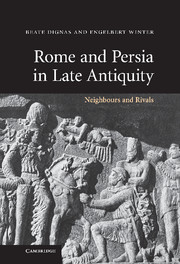Book contents
- Frontmatter
- Contents
- List of figures
- List of maps
- Preface
- Abbreviations
- Introduction: West and East, friend and foe, counterpart and mirror image …
- PART I NARRATIVE
- PART II SOURCES AND CONTEXTS
- 1 Political goals
- 2 Warfare
- 3 Military confrontations
- 4 The diplomatic solutions
- 5 Arabia between the great powers
- 6 Shared interests: Continuing conflicts
- 7 Religion: Christianity and Zoroastrianism
- 8 Emperor and King of kings
- 9 Exchange of information between West and East
- Appendix 1 Lists of Sasanian kings and Roman emperors
- Appendix 2 Chronological table
- Appendix 3 Glossary
- Bibliography
- Index of sources
- Index of translated sources
- Index of names
- Index of place names
- General index
6 - Shared interests: Continuing conflicts
Published online by Cambridge University Press: 05 June 2012
- Frontmatter
- Contents
- List of figures
- List of maps
- Preface
- Abbreviations
- Introduction: West and East, friend and foe, counterpart and mirror image …
- PART I NARRATIVE
- PART II SOURCES AND CONTEXTS
- 1 Political goals
- 2 Warfare
- 3 Military confrontations
- 4 The diplomatic solutions
- 5 Arabia between the great powers
- 6 Shared interests: Continuing conflicts
- 7 Religion: Christianity and Zoroastrianism
- 8 Emperor and King of kings
- 9 Exchange of information between West and East
- Appendix 1 Lists of Sasanian kings and Roman emperors
- Appendix 2 Chronological table
- Appendix 3 Glossary
- Bibliography
- Index of sources
- Index of translated sources
- Index of names
- Index of place names
- General index
Summary
Although Roman–Persian relations were dominated by military conflicts or diplomatic activities concerning these conflicts, there were a number of issues that showed points of contact between the two powers, which, however, could themselves become the starting point for further tensions. These are above all economic and trade related issues, the protection of the frontier and the integration of territories that had been contested for centuries. It is noteworthy that the contemporary authors always give their accounts on the basis of an ‘imaginary opposition’ between Occident and Orient, which creates a typical ‘perspective of confrontation’. One cannot fail to notice the prejudices the Roman historians held against the ‘oriental barbarians’. Such commonplaces, which found their way into Western literature many centuries ago, and which were embellished in numerous subsequent accounts given by those travelling between the cultures – soldiers or diplomats, scholars or philosophers, artists or missionaries – have had a tremendous impact on modern views until the present day. The second part of this book thus emphasises the contrary, namely the efforts to reconcile differences, the openness for cooperation between the powers and the solutions that were found in the process and thereby to gain a deeper understanding of Roman–Sasanian relations. Given how the rivalries between Rome and Persia persisted and how difficult in particular the geographical conditions in the border regions were, these solutions can indeed be called innovative and forward-looking. At times, they certainly helped to stabilise the difficult political situation in the contested border territories along the Euphrates and Tigris.
- Type
- Chapter
- Information
- Rome and Persia in Late AntiquityNeighbours and Rivals, pp. 173 - 209Publisher: Cambridge University PressPrint publication year: 2007



